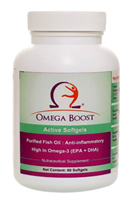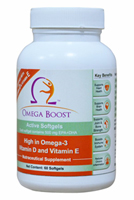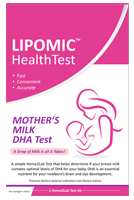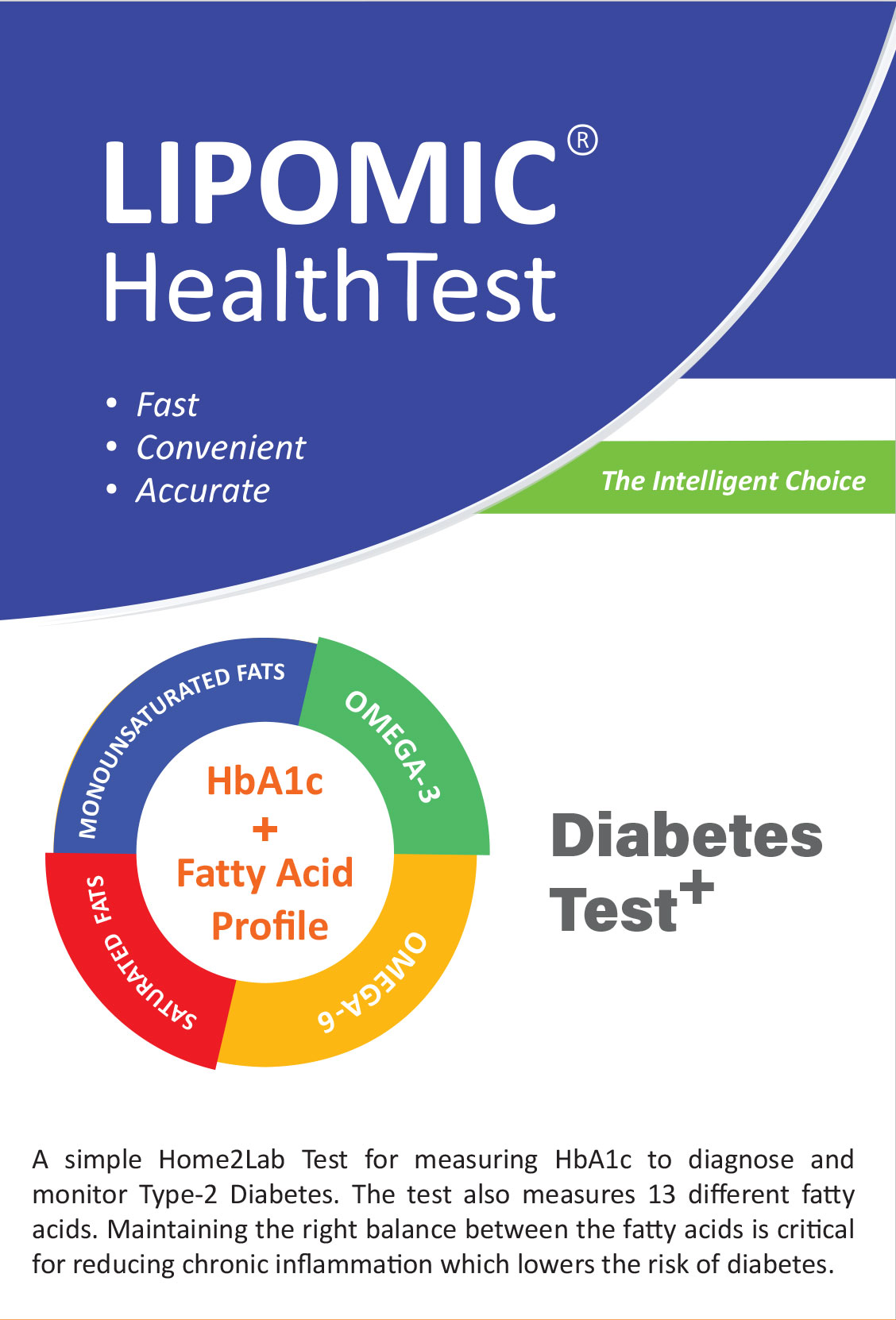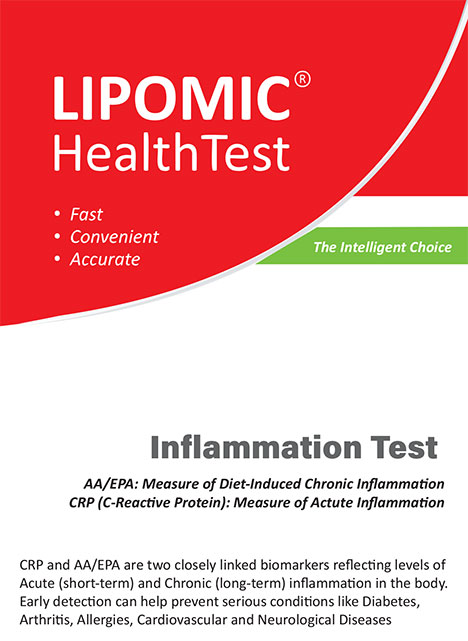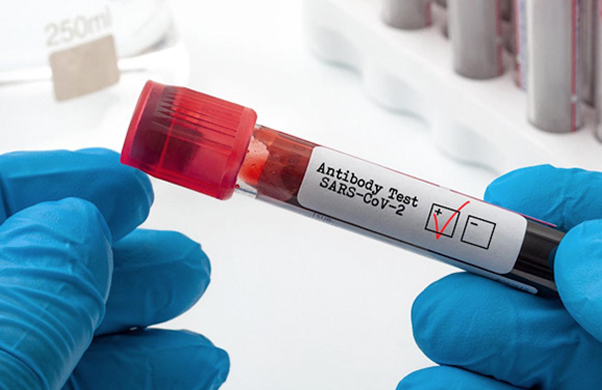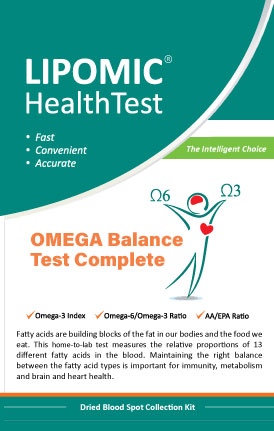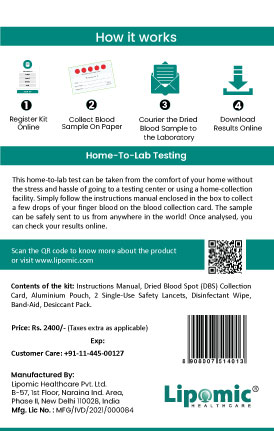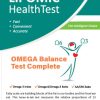Omega Balance Test Complete
Omega HealthTest Complete measures 30 fatty acids in your blood, including Omega-3 and Omega-6 polyunsaturated fatty acids, saturated fatty acids, monounsaturated fatty acids, and Trans-fatty acids.
Fats are the densest source of energy providing 9 calories per gram. Dietary guidelines from the World Health Organization and the Dietary Reference Intakes recommend a total fat intake between 20 and 35% of total calories. Even more crucial than simply the quantity of fats consumed is ensuring a well-balanced fatty acids profile. A balanced fatty acid profile has long term health benefits and will make you confident that you are on the right track to maintaining a healthy life-style and good health.
- Omega-3 index
- Omega-6/Omega-3 ratio
- AA/EPA ratio
- Palmitic acid (PA) index
Key Indicators Reported:
Omega Balance Test Complete
₹2,400.00
Only customers holding Indian debit or credit cards may place their order through this portal. International customers are requested to write to us at info@lipomic.com so that we may assist them in placing the order.
General FAQs
Home-to-lab testing allows individuals to collect samples comfortably at home. The main advantages of home sampling include convenience, privacy, and accessibility, as individuals can perform the tests at their own convenience.
Once the sample is collected, it is sent to our laboratory for analysis from anywhere in the world. You will be notified on your registered email once the results are ready, and can be downloaded from your registered account.
DBS testing is no more painful than a self-prick for a glucometer test. The kit contains one-time-use safety lancets which are used for pricking a finger and depositing a sample on a special filter paper card. The blood spot deposited on the filter paper card is allowed to dry, and hence the name dried blood spot.
Similarly, some tests may require saliva, urine or stool samples, which can also be collected on special filter paper cards. This makes the sample collection completely non-invasive.
Watching the instructional video and carefully reading the instruction manual before conducting the test should ensure a smooth experience. Should you encounter any difficulties, please do not hesitate to contact us for assistance.
Once we receive your sample, the average response time is 7-10 business days to receive the results.
Lipomic LifeSciences can provide evidence-based suggestions for lifestyle changes that you can make to positively impact your health. We can also connect you with leading medical experts who can guide and discuss potential next steps.
Test Specific FAQs
You can take this test any time of the day. However, if you take Omega-3 supplements it is recommended that you take the test before taking the Omega-3 supplements.
The Omega-3 index is a measure of the amount of omega-3 fatty acids, specifically EPA (eicosapentaenoic acid) and DHA (docosahexaenoic acid), in your red blood cell membranes. It is expressed as a percentage of the total fatty acids present in the membranes.
A higher Omega-3 index is associated with several health benefits, including a reduced risk of cardiovascular disease, improved brain function, and lower inflammation. Here’s how the index is generally interpreted:
- Low Omega-3 Index (≤ 3%): Indicates a higher risk of cardiovascular disease.
- Intermediate Omega-3 Index (3-8%): Suggests a moderate risk of cardiovascular disease.
- Optimal Omega-3 Index (≥ 8%): Associated with the lowest risk of cardiovascular disease and the greatest health benefits.
The Omega-6/Omega-3 ratio refers to the ratio of two types of polyunsaturated fatty acids (PUFAs) in the diet: Omega-6 fatty acids (such as linoleic acid) and Omega-3 fatty acids (such as alpha-linolenic acid, EPA, and DHA).
A balanced Omega-6/Omega-3 ratio is important for maintaining optimal health, as both types of fatty acids play essential roles in the body. However, in modern Western diets, this ratio is often skewed towards higher Omega-6 intake compared to Omega-3. This imbalance is believed to contribute to chronic inflammation and various health issues.
The ideal ratio of Omega-6 to Omega-3 fatty acids in the diet is considered to be around 3:1 or lower. Some health experts suggest that a ratio closer to 1:1 may be even more beneficial for overall health. However, typical modern diets often have ratios much higher, sometimes exceeding 10:1 or even 20:1, due to high consumption of vegetable oils rich in Omega-6 (like corn oil, soybean oil, and sunflower oil) and lower intake of Omega-3-rich foods (like fatty fish, flaxseeds, and walnuts).
To improve your Omega-6/Omega-3 ratio, you can:
- Increase consumption of Omega-3-rich foods, such as fatty fish (salmon, mackerel, sardines), flaxseeds, chia seeds, and walnuts.
- Choose cooking oils with a healthier balance of Omega-6 to Omega-3, like olive oil or canola oil.
- Reduce intake of processed foods and snacks containing high amounts of vegetable oils.
- Consider supplementing with Omega-3 fish oil or algae oil capsules if your diet is lacking in Omega-3 fatty acids.
Maintaining a balanced Omega-6/Omega-3 ratio is thought to support heart health, reduce inflammation, and promote overall well-being.
The AA/EPA ratio refers to the ratio of two specific types of omega-3 and omega-6 fatty acids found in the body:
- Arachidonic Acid (AA): This is an omega-6 fatty acid that is important for inflammatory processes and other physiological functions.
- Eicosapentaenoic Acid (EPA): This is an omega-3 fatty acid found in fish oil and certain algae. EPA has anti-inflammatory properties and is associated with various health benefits.
As a result, the AA/EPA ratio is a novel marker of diet induced inflammatory response. It is recommended to maintain an AA/EPA ratio of less than 3, leading to reduced inflammation, improved cardiovascular health, and lowered risk of inflammatory-related diseases.
Palmitic acid (PA) index represents the relative proportion of PA in your blood. Palmitic acid is a type of saturated fatty acid commonly found in various foods, including animal fats, palm oil, and palm kernel oil. High intake of palmitic acid has been associated with adverse health effects, including increased LDL (low-density lipoprotein) cholesterol levels, which is a risk factor for cardiovascular disease.
Trans Fat Index measures the trans fats from industrial production and should be below 1%.
Trans fats, or trans fatty acids, are a type of unsaturated fat that have undergone a process called hydrogenation. This process changes the structure of the fat molecules, making them more stable and solid at room temperature. Trans fats are primarily created through industrial hydrogenation of vegetable oils, which turns liquid oils into solid fats.
Trans fats can also occur naturally in small amounts in some animal products. However, the main concern arises from industrially produced trans fats, which are found in many processed and commercially prepared foods. These include:
- Fried Foods: Such as French fries, doughnuts, and fried chicken.
- Baked Goods: Such as cakes, cookies, pies, and pastries.
- Snack Foods: Such as potato chips and microwave popcorn.
- Margarine: Especially stick margarine, which is solid at room temperature.
- Packaged Snacks: Such as crackers, snack cakes, and microwaveable snacks.
- Non-Dairy Creamers: Some varieties contain trans fats.
Health authorities have identified trans fats as particularly harmful to health, as they increase levels of “bad” LDL cholesterol and lower levels of “good” HDL cholesterol in the bloodstream. This can significantly raise the risk of heart disease, stroke, and type 2 diabetes. As a result, many health organizations recommend minimizing or eliminating trans fats from the diet.
In response to health concerns, some countries have implemented regulations to limit the use of trans fats in food production. This has led to reformulations of many processed foods to reduce or eliminate trans fats, improving public health outcomes.
Sample Report
General FAQs
Home-to-lab testing allows individuals to collect samples comfortably at home. The main advantages of home sampling include convenience, privacy, and accessibility, as individuals can perform the tests at their own convenience.
Once the sample is collected, it is sent to our laboratory for analysis from anywhere in the world. You will be notified on your registered email once the results are ready, and can be downloaded from your registered account.
DBS testing is no more painful than a self-prick for a glucometer test. The kit contains one-time-use safety lancets which are used for pricking a finger and depositing a sample on a special filter paper card. The blood spot deposited on the filter paper card is allowed to dry, and hence the name dried blood spot.
Similarly, some tests may require saliva, urine or stool samples, which can also be collected on special filter paper cards. This makes the sample collection completely non-invasive.
Watching the instructional video and carefully reading the instruction manual before conducting the test should ensure a smooth experience. Should you encounter any difficulties, please do not hesitate to contact us for assistance.
Once we receive your sample, the average response time is 7-10 business days to receive the results.
Lipomic LifeSciences can provide evidence-based suggestions for lifestyle changes that you can make to positively impact your health. We can also connect you with leading medical experts who can guide and discuss potential next steps.
Test Specific FAQs
You can take this test any time of the day. However, if you take Omega-3 supplements it is recommended that you take the test before taking the Omega-3 supplements.
The Omega-3 index is a measure of the amount of omega-3 fatty acids, specifically EPA (eicosapentaenoic acid) and DHA (docosahexaenoic acid), in your red blood cell membranes. It is expressed as a percentage of the total fatty acids present in the membranes.
A higher Omega-3 index is associated with several health benefits, including a reduced risk of cardiovascular disease, improved brain function, and lower inflammation. Here’s how the index is generally interpreted:
- Low Omega-3 Index (≤ 3%): Indicates a higher risk of cardiovascular disease.
- Intermediate Omega-3 Index (3-8%): Suggests a moderate risk of cardiovascular disease.
- Optimal Omega-3 Index (≥ 8%): Associated with the lowest risk of cardiovascular disease and the greatest health benefits.
The Omega-6/Omega-3 ratio refers to the ratio of two types of polyunsaturated fatty acids (PUFAs) in the diet: Omega-6 fatty acids (such as linoleic acid) and Omega-3 fatty acids (such as alpha-linolenic acid, EPA, and DHA).
A balanced Omega-6/Omega-3 ratio is important for maintaining optimal health, as both types of fatty acids play essential roles in the body. However, in modern Western diets, this ratio is often skewed towards higher Omega-6 intake compared to Omega-3. This imbalance is believed to contribute to chronic inflammation and various health issues.
The ideal ratio of Omega-6 to Omega-3 fatty acids in the diet is considered to be around 3:1 or lower. Some health experts suggest that a ratio closer to 1:1 may be even more beneficial for overall health. However, typical modern diets often have ratios much higher, sometimes exceeding 10:1 or even 20:1, due to high consumption of vegetable oils rich in Omega-6 (like corn oil, soybean oil, and sunflower oil) and lower intake of Omega-3-rich foods (like fatty fish, flaxseeds, and walnuts).
To improve your Omega-6/Omega-3 ratio, you can:
- Increase consumption of Omega-3-rich foods, such as fatty fish (salmon, mackerel, sardines), flaxseeds, chia seeds, and walnuts.
- Choose cooking oils with a healthier balance of Omega-6 to Omega-3, like olive oil or canola oil.
- Reduce intake of processed foods and snacks containing high amounts of vegetable oils.
- Consider supplementing with Omega-3 fish oil or algae oil capsules if your diet is lacking in Omega-3 fatty acids.
Maintaining a balanced Omega-6/Omega-3 ratio is thought to support heart health, reduce inflammation, and promote overall well-being.
The AA/EPA ratio refers to the ratio of two specific types of omega-3 and omega-6 fatty acids found in the body:
- Arachidonic Acid (AA): This is an omega-6 fatty acid that is important for inflammatory processes and other physiological functions.
- Eicosapentaenoic Acid (EPA): This is an omega-3 fatty acid found in fish oil and certain algae. EPA has anti-inflammatory properties and is associated with various health benefits.
As a result, the AA/EPA ratio is a novel marker of diet induced inflammatory response. It is recommended to maintain an AA/EPA ratio of less than 3, leading to reduced inflammation, improved cardiovascular health, and lowered risk of inflammatory-related diseases.
Palmitic acid (PA) index represents the relative proportion of PA in your blood. Palmitic acid is a type of saturated fatty acid commonly found in various foods, including animal fats, palm oil, and palm kernel oil. High intake of palmitic acid has been associated with adverse health effects, including increased LDL (low-density lipoprotein) cholesterol levels, which is a risk factor for cardiovascular disease.
Trans Fat Index measures the trans fats from industrial production and should be below 1%.
Trans fats, or trans fatty acids, are a type of unsaturated fat that have undergone a process called hydrogenation. This process changes the structure of the fat molecules, making them more stable and solid at room temperature. Trans fats are primarily created through industrial hydrogenation of vegetable oils, which turns liquid oils into solid fats.
Trans fats can also occur naturally in small amounts in some animal products. However, the main concern arises from industrially produced trans fats, which are found in many processed and commercially prepared foods. These include:
- Fried Foods: Such as French fries, doughnuts, and fried chicken.
- Baked Goods: Such as cakes, cookies, pies, and pastries.
- Snack Foods: Such as potato chips and microwave popcorn.
- Margarine: Especially stick margarine, which is solid at room temperature.
- Packaged Snacks: Such as crackers, snack cakes, and microwaveable snacks.
- Non-Dairy Creamers: Some varieties contain trans fats.
Health authorities have identified trans fats as particularly harmful to health, as they increase levels of “bad” LDL cholesterol and lower levels of “good” HDL cholesterol in the bloodstream. This can significantly raise the risk of heart disease, stroke, and type 2 diabetes. As a result, many health organizations recommend minimizing or eliminating trans fats from the diet.
In response to health concerns, some countries have implemented regulations to limit the use of trans fats in food production. This has led to reformulations of many processed foods to reduce or eliminate trans fats, improving public health outcomes.
Sample Report

